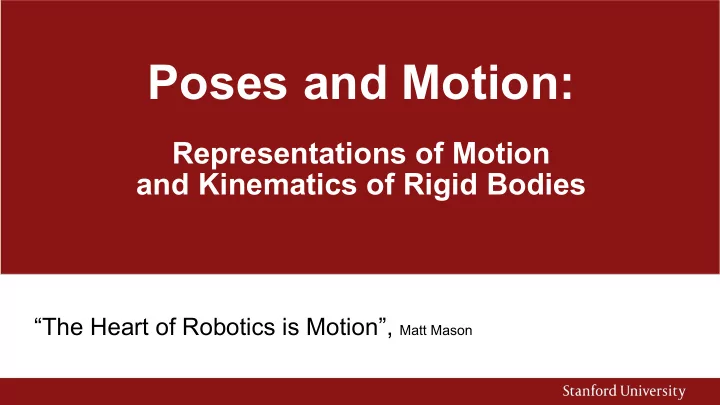

Poses and Motion: Representations of Motion and Kinematics of Rigid Bodies “The Heart of Robotics is Motion”, Matt Mason
Representations of Rotations 1) Rotation Matrix (direction cosine matrix) 2) Exponential Coordinates (Axis-angle) 3) Euler angles 4) Quaternion
Why so many representations for rotation? 1) Rotation Matrix (direction cosine matrix) 2) Exponential Coordinates (Axis-angle) + Operations on other geometric elements + Minimal representation + Composition + Intuitive to “visualize” - 9 elements for 3 DoF - Interpolation - Interpolation - Operations on other geometric elements - Composition 3) Euler angles 4) Quaternion + Intuitive to “define” + “Almost” minimal representation + Minimal representation + “Almost” intuitive to “visualize” + Interpolation (SLERP) - Gimbal lock - Composition - Operations on other geometric elements - Operations on other geometric elements
Gimbal Lock
Representations of Poses 1) Homogeneous Transformation Matrix 2) Exponential Coordinates (Twist) Any combination of rotation representation + translation
Why so many representations for pose? 1) Homogeneous Tranformation Matrix 2) Exponential Coordinates (Twist) + Operations on other geometric elements + Minimal representation + Composition + Good for optimization and iterative error minimization - 16 elements for 6 DoF - Interpolation - Interpolation - Operations on other geometric elements - Composition
What will we learn - Fundamentals of Motion Recap of Linear Algebra and Linear Differential Equation ● Representation of rotations ● Lie Group - Lie Algebra and Exponential Coordinates ○ Pose, Homogeneous transformation matrix ● Kinematics of rigid bodies ●
Recap So far : Poses, motion between two time steps t0 and t1 ● (we used velocity, e.g. , only to derive exponential coordinates) Now : Continuous change in pose over time -> velocity ●
Kinematics of Rigid Bodies - Angular Velocity Given the orientation R(t) of a rotating frame as a function of time t, what is its angular velocity?
̇ Rotational Velocity in Space and Body Frame Def: Rotational velocity in space frame: Given the orientation 𝑆 "# (𝑢) of a rotating frame {b} at time t. The (instantaneous) angular velocity vector w of frame {b} defined in frame {s} is *+ 𝑥 " = 𝑆 "# 𝑆 "# The same velocity defined in frame {b} is *+ ̇ 𝑥 # = 𝑆 "# 𝑆 "#
Integrating Angular Velocity into Rotation Matrix Given the constant angular velocity of a body, what is the orientation after t seconds?
Kinematics of Rigid Bodies - Twists as Rigid Body Velocity
Adjoint Transform
Spatial Twist and Body Twist – Interpretations
Integrating Velocity Twists into Transformation Matrix
Transforming Clouds of Points
Estimating a Transformation from two Clouds of Points 1. Compute centroids 2. Generate H 1. Compute R 1. Compute t
RANSAC [Fischler & Bolles, 81] RANdom SAmple Consensus ● Algorithm to estimate the parameters of model from data with outliers (for ● example, parameters of a line or of a rigid pose) RANSAC loop: ● ○ Randomly select a “seed group” of points on which to base transformation estimate (e.g., a group of matches) ○ Compute parameters from seed group ○ Find inliers to this model ○ If the number of inliers is sufficiently large, re-compute least-squares estimate of model on all of the inliers ○ Keep model with the largest number of inliers
RANSAC [Fischler & Bolles, 81] ● Approach: we want to avoid the impact of outliers, so let’s look for “inliers”, and use only those ● Intuition: if an outlier is chosen to compute the current fit, then the resulting group won’t have much support from the rest of elements
Pros and Cons of RANSAC Pros: ● ○ General method suited for a wide range of model fitting problems ○ Easy to implement and easy to calculate its failure rate Cons: ● ○ Only handles a moderate percentage of outliers without cost blowing up ○ Many real problems have a high rate of outliers (but sometimes selective choice of random subsets can help)
RANSAC Exercise - Prior Given two points (x1,y1), (x2,y2), the line connecting them is: And the distance of a point (x0,y0) to the line can be calculated as:
Questions?
Recommend
More recommend